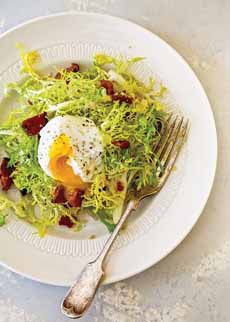TIP OF THE DAY: Salad Mashup (Your Signature Salad)
|
Here’s what you get when you combine three salad concepts: Sure, people have been substituting lobster for the chicken to make a Lobster Cobb Salad; but how about substituting romaine or frisée for the iceberg lettuce? We have a list below of salads for your mashup; but first, the Wainter: All three of these salads have been popular for decades—even centuries. Two are American creations, one is French. Cobb Salad (photo #2)was created in 1937 at the Brown Derby restaurant in Hollywood: an on-the-fly assembly of whatever was in the kitchen one late night. Owner Bob Cobb was scrounging in the kitchen’s refrigerator for a snack for himself and Sid Grauman, proprietor of Grauman’s Chinese Theatre. He compiled a plate of romaine lettuce, tomatoes, cold breast of chicken, hard-boiled egg, chives, blue cheese, bacon and some watercress. The original French dressing used was synonymous at the time with vinaigrette—the standard salad dressing of France. Over time, a sweet, decidedly non-French, orange-colored vinaigrette (from ketchup, not a very French condiment) appeared in the U.S. and Canada. It’s what “French dressing” is today. To make it, combine 1/4 cup white wine vinegar, 1/3 cup olive oil, 1/4 cup ketchup, 1 tablespoon sugar, 2 teaspoons paprika, 1 teaspoon Worcestershire sauce, a pinch of salt. Our mother halved the sugar and threw in a clove of garlic. But we prefer the original vinaigrette, or even better, a chunky blue cheese dressing. The salad created on that long-ago evening was so delicious, that Sid Grauman came back the next day and asked for a “Cobb Salad.” It went onto the menu, and never left. (The restaurant was destroyed by fire in 1987.) Here’s more of the history of Cobb Salad. Cooked eggs on salads have long been part of French cuisine. The most noteworthy: Wedge Salad (photo #3) began to emerge in the 1950s, when restaurants offered hearts of iceberg lettuce salad with creamy dressings. The head was cut into quarters and plated with a slice of tomato for color. Homemakers were fans, too, because iceberg heads were sold fully trimmed, with little waste, and had a longer shelf life in the fridge. It was easy to cut into wedges or slice into shreds. The lettuce’s crunch was very popular, if bland-tasting (solution: lots of dressing—like creamy blue cheese). Thanks to the retro food movement of the past decade, iceberg has returned to restaurant menus beyond its steakhouse stronghold, and the hearts of lettuce salad are now known by a trendier name: wedge salad. Bacon was added, because bacon has become a garnishs of choice. By the way, iceberg lettuce was a mutation, discovered in the late 1800s. Here’s the history of iceberg lettuce, and more about wedge salads. |
|
|
|
In addition to the three salads above, here are 10 more popular green salads with ingredients you can pick and choice to make a [Your Name Here] Salad.
|
||






